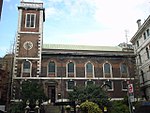Faraday Building

The Faraday Building is in the south-west of the City of London. It was originally built as a sorting office for the General Post Office. In 1902 it was converted to a telephone exchange serving sections of London, and underwent several capacity expansions over the next several years. In 1933, a new section was added on the western side of the building, over doubling the size of the building as a whole. The section was built to house the International Telephone Exchange. The new section included a raised central portion with decorative turrets which was highly controversial at the time as it blocked the view of St. Paul's Cathedral from the Thames River. This led to a new law that restricted the height of new buildings in London to protect the sightlines of the Catherdral. Although generally five stories high, the central section and rectangular turrets roughly double that and remain a high point in the area in spite of a century of new building in the area. It fronts Queen Victoria Street and backs onto Knightrider Street. The block is one narrow block east from Peters Hill which is the northern footpath to/from the Millennium Bridge. BT Group still uses the building, although today it is rented as general offices and retail space.
Excerpt from the Wikipedia article Faraday Building (License: CC BY-SA 3.0, Authors, Images).Faraday Building
Knightrider Street, City of London
Geographical coordinates (GPS) Address External links Nearby Places Show on map
Geographical coordinates (GPS)
| Latitude | Longitude |
|---|---|
| N 51.5122 ° | E -0.1002 ° |
Address
BT Faraday (BT Wholesale)
Knightrider Street
EC4V 5BJ City of London
England, United Kingdom
Open on Google Maps











